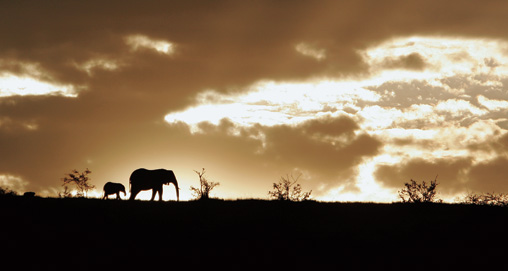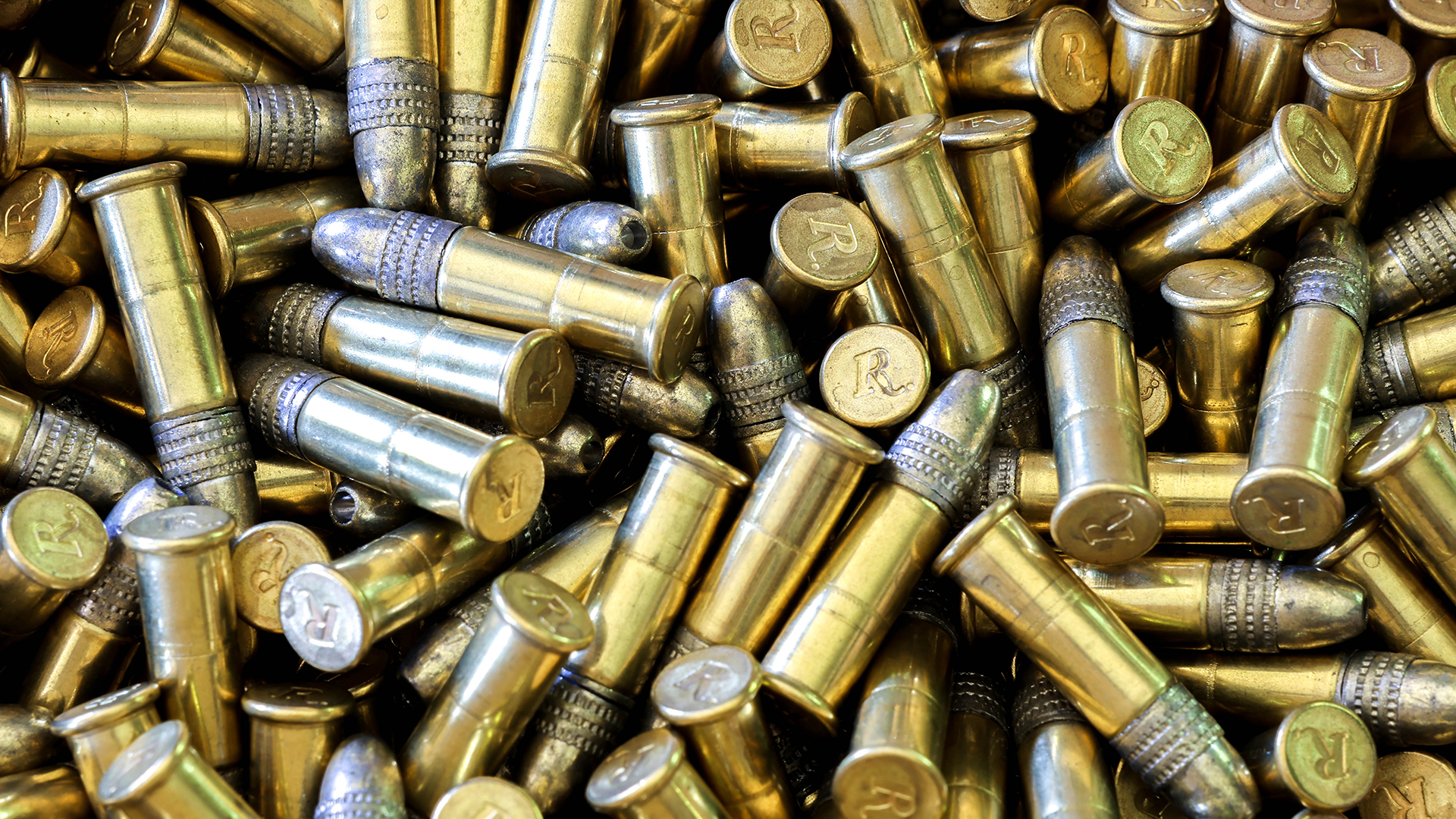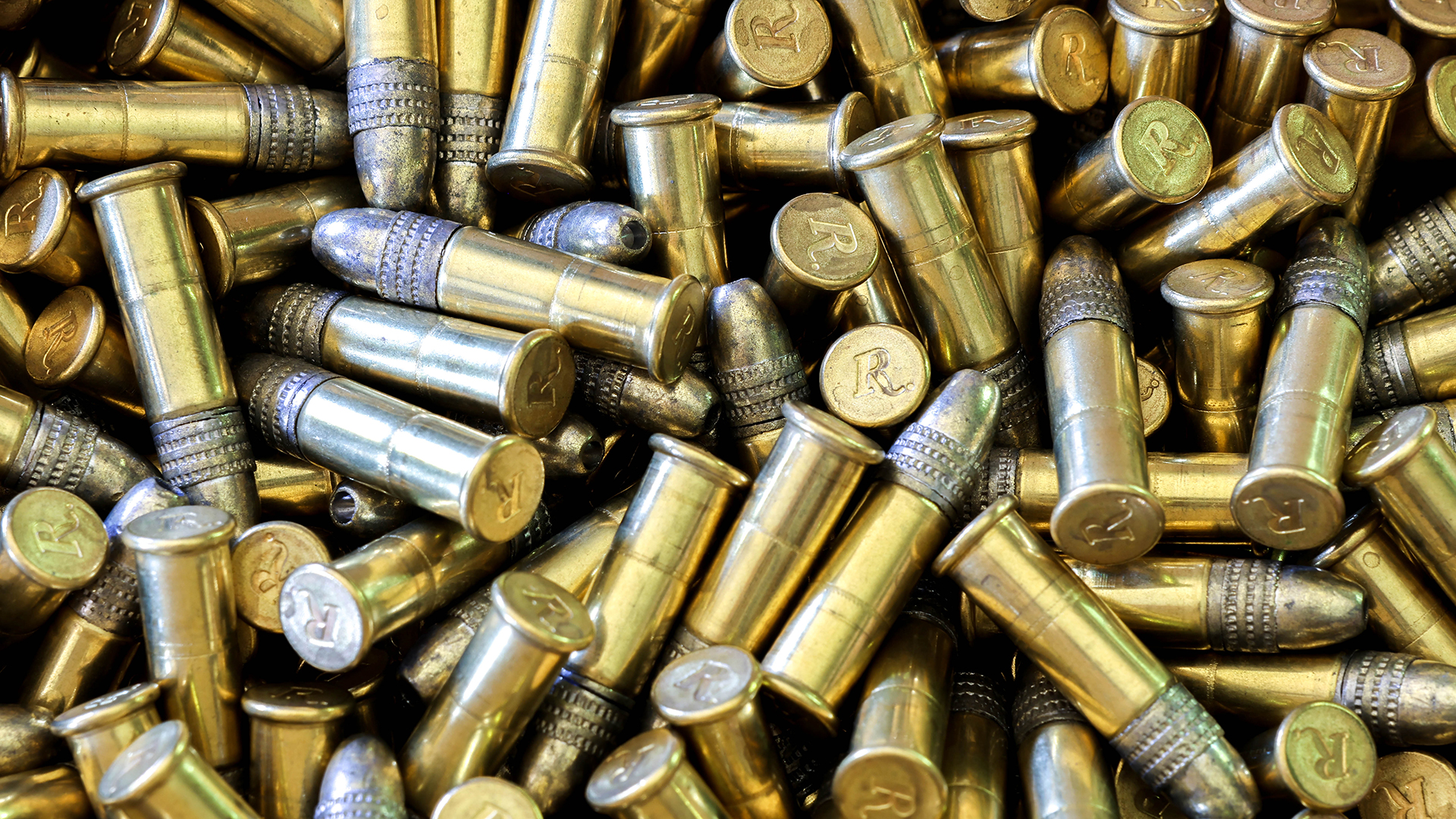
2/7/2011
The desire to hunt elephants is as foreign and different as the animal itself for most hunters who've never been to Africa. It's difficult for most people to imagine hunting such an animal before they've experienced the excitement, and danger, of tracking one through thick African bush. But for those who have felt the surge of adrenaline in the final approach to a massive tusker, elephant hunting is the epitome of all hunting experiences. Many hunters consider the taking of a big tusker, one carrying more than 100 pounds per side, to be the pinnacle of achievement—the holy grail of big game hunting.
The African elephant is larger than any other land animal by more than 2 tons. Ironically, a unique bone structure in the round, flat feet that carry his bulk, 6 or 7 tons of it, biologically links him to a family of animals where his closest African relative is a small, 6- or 7-pound, rock-climbing creature called a hyrax. In today's world, the elephant seems an enigma, a holdover from the Pleistocene Era. This may be why we're so inexplicably drawn to him. Elephants provide us with a historical perspective, reminding us of the way the world used to be.
One's first sight of a wild African elephant is truly unforgettable. His enormous size alone establishes this incredible creature as the true "king of beasts." My first look at one took place in Kenya back in 1967. As we drove across the red dusty plains of Tsavo National Park, my father suddenly braked the Land Rover and pointed to the horizon on our left-three enormous bulls strode across the open plain. They were coated with Tsavo's red soil, the color of old rusty locomotives. Several feet of gleaming ivory weighed heavily on their heads as they lumbered across a silvery carpet of dry grass past broken and twisted acacia and commiphora trees, evidence of prior elephant feedings. They showed no interest in us as they pressed on, possibly toward a waterhole to quench their thirst or some shade in which to stand. The midday African sun beat down on the Tsavo savannah as we watched the bulls until they disappeared into the distant shimmering heat haze. With that first look, the seed of desire to one day hunt such a beast was planted.
My opportunity to hunt in Kenya came about when my family moved there in the 1960s. My father was one of three Pan American pilots who ferried personnel and supplies from Kenya out to the U.S. satellite tracking station on Mahe, the main island of the Seychelles, located 1,000 miles east of Kenya in the Indian Ocean. They flew an amphibious Grumman aircraft called an Albatross out to the islands once a week from the coastal city of Mombasa, where we lived for six years.
For the first couple of years, my father and I were more than satisfied to hunt common plains game, species such as impala, warthog, zebra, wildebeest and Grant's gazelle, and later more challenging species like eland, lesser kudu, gerenuk and fringe-eared oryx. As consummate bird shooters, we thought we'd found heaven on Earth when we discovered the variety of gamebirds occurring in the hunting areas. Doves, sand grouse, francolin, guinea fowl, ducks and geese provided many exciting and often hot-barreled shoots in addition to the big-game hunting we enjoyed.
Kenya's resident hunters were not required to hunt with a professional hunter, so we did so on our own or with friends, and eventually gained the experience to step up to Africa's dangerous game, commonly called the "Big Five"—elephant, buffalo, rhino, lion and leopard. Kenya game laws were justifiably strict concerning the issue of dangerous-game licenses to resident hunters. You had to first acquire sufficient knowledge about the game and the various hunting areas. Then, after some basic hunting experience was gained, you had to pass both written and oral examinations administered by the Kenya Game Department. Final approval for a new applicant's request for a dangerous-game license was granted at the discretion of the chief game warden, who often required that you first observe a dangerous-game hunt before he'd sign off on a first-time application.
Satisfying game department rules and regulations was more than just red tape. It ensured that hunters were fully qualified before they were granted permission to hunt dangerous game. The demands of hunting dangerous game oblige you to be prepared physically and mentally to shoulder both rifle and responsibility. The whole perspective of our hunts changed with the added element of danger, and we learned to hunt the Big Five with respect and caution. Robert Ruark once wrote that to hunt dangerous game, "you have to be scared enough to be cautious, but brave enough to control your fear," an emotional balance that enables you to face an angry elephant or track a wounded buffalo into thick bush.
I arrived in Nairobi for the summer of 1970, fresh from completing my sophomore year at college. Joining my dad and I for the summer was Mike Brennan, a long-time friend and hunting companion who I'd grown up with, hunting ducks and doves among the mangrove islands of the Banana River near Cape Canaveral, Fla. After hearing me talk about my hunting experiences from previous summers, Mike was determined to visit Kenya and he'd finally made it.
That was the summer we began to hunt dangerous game, and my father had planned three months of big-game hunting for us. Our do-it-yourself safaris took us from the beautiful game-filled plains of Maasailand, located in the shadow of Mt. Kilimanjaro, to the legendary big elephant areas adjacent to Tsavo National Park. In between hunts Mike and I often drove up to Tsavo from the coast for day-trips to film game with a 16mm movie camera. By the end of August, we'd spent many days in the bush and had been successful with both hunting and filming.
Our last hunt of the summer began the first week of September, just before Mike and I returned to college. My father booked Block 21-A, an excellent hunting area adjacent to Tsavo National Park and bordered in the north by the Galana River. This was also an outstanding area for lesser kudu, gerenuk and fringe-eared oryx. The previous rainy season had seen below-average rainfall, leaving many waterholes to dry up quickly. By September game was concentrated near permanent water sources like the Galana.
We drove into Block 21-A a day early by way of a remote Waliangulu village, hoping to find Abakuna Tise, a legendary native elephant hunter. Professional hunters often sought Abakuna for his knowledge of the area and his invaluable elephant expertise. He'd hunted tuskers extensively with bow and arrow; he was regarded as an ace hunter among his own tribe, and begrudgingly by the Kenya Game Department, who tried to apprehend him, often in vain, during his poaching years. In fact Abakuna was credited with killing more than 100 elephants with his bow. A fascinating account of that bygone era, in which Abakuna played a major role, is told by Dennis Holman in his excellent book, The Elephant People.
We were fortunate indeed that Abakuna was at the village, and he said he'd be pleased to accompany us. Our other two trackers, Kiribai and Barissa, were also Waliangulu from the Galana country and knew the area intimately. Thus we assembled a truly dream team of native elephant hunters to assist us.
After Abakuna and his gear was loaded aboard the Land Rover, we continued northward toward the Galana following a faint, sandy and very bumpy 60-mile track through the bush. It was late afternoon when we arrived at the river. Judging by the carpet of droppings littering the paths leading to it, there appeared to be no shortage of elephants drinking along its banks. Most of the sign was from breeding herds, and their movement to and from the river had created well-worn trails through the bush of low, gray acacia thorn scrub.
Dawn broke cool the next morning with gray, overcast skies threatening a drizzle of rain. My father woke first and stoked the campfire, filling the kettle with water and putting it on the fire for coffee. By the time the water boiled, Mike and I were up and huddled near the fire. After coffee and breakfast, we pulled out of camp around 7 a.m. Within a short distance of camp, we picked up the fresh tracks of two buffalo bulls, which we decided to follow, hoping to catch up to them before they laid up in shade for the day. Concentrating on the two sets of tracks, we suddenly discovered we'd come upon a herd of 50 or so elephants. We were close, and when the wind shifted, blowing our scent to them, the herd suddenly stampeded straight toward us. To avoid being stepped on by the charging elephants we raced down a game path, dodging and darting through the bush, broken-field fashion. Fortunately, they passed close by us, but kept going.
We were still winded from our dash through the bush when Kiribai spotted a rhino cow and calf ambling down another game trail coming straight for us. Black rhino were still plentiful in those days, and we considered them mostly a nuisance because of their propensity for charging anything or anybody they came across. At the time, rhino poaching was just beginning to get serious, and many of them wore scars or suffered injuries from the effects of inefficient bullets and arrows. Because of this they exhibited a more than normal belligerent attitude. With a dependent calf at her side, the instant she became aware of us, this mama rhino quickly slipped into a nasty mood. We slowly but surely backed away to negate further incident and returned to the Land Rover, giving up any hope of finding the buffalo. Abakuna, Kiribai and Barissa were unfazed by all the drama and considered the morning's events highly amusing.
We returned to camp for lunch, and left right afterwards to continue hunting. Abakuna was anxious to keep moving in order to have enough time to drive out to a large waterhole he knew of to see if it might still hold water. It meant driving away from the river and into the drier bush country, but Abakuna knew that if there was water, there'd be bull elephants drinking there. There were also a few strategic hills located in the same area—hills we could climb for a commanding view of the surrounding bush.
We hadn't driven more than 30 minutes when Kiribai tapped frantically on the top of the Land Rover: My father knew what that meant, and he stopped immediately, switching off the engine at the same time.
Kiribai leaned down, flashing a broad smile, and said, "Bwana, iko ndovu kubwa sana!" in a rushed whisper. The translation was simple: "There's a very big elephant." But the inference was more like, "Bwana, come, we need to go quickly."
I looked to the left of the vehicle and caught a glimpse of a single elephant as he quickly and silently drifted from sight among the gray commiphora trees. He moved toward the Tsavo boundary and Abakuna didn't wait as he leapt off the back of the Rover and followed the bull into the leafless woodland to keep him in sight. We needed to hurry.
I took one of the Winchester M70 .458s from the gun rack, while Kiribai quickly pulled a second .458 from a soft gun case and handed it to my dad. The rifle I held was stoked with three solids, and I placed another one directly into the chamber. I flicked the safety on and looked at my father and Mike; their serious expressions mirrored my own. Kiribai had already moved quickly down the same path Abakuna took, and we hustled to catch up.
When we caught up to Abakuna, he'd stopped and was grinning from ear to ear, shaking his head in amazement at the size of the tusks he'd just seen. He shoved his arms forward to mimic the length of the elephant's tusks, and then turned and waved us on to continue following the elephant.
The sound ahead of a branch snapping told us the elephant was not very far from us. For the next few yards, we moved in a crouching run that suddenly brought us to the elephant's huge, dust-covered back. He stood facing away from us like a statue, his head cocked and listening. We froze in our tracks. Having initially moved away from the noise of the Land Rover, the elephant now listened for any further sounds that might mean danger.
I thought to myself, There's no turning back now, as I looked up at the high, curved back of the old bull. The end of his tail sported a growth of long hairs as thick as heavy fishing line. They brushed against his mud-caked hide as his tail swished back and forth. Large, rough growths covered the thick skin on his back like barnacles, the result of many years of exposure to the hot equatorial sun. When he fanned his huge ears, they made a clopping sound against his shoulders.
The wrinkled and deeply creased skin was caked with dried, rust-colored mud. If you were very close, close enough to hear him breath, you could see short, thick bristles of hair covering much of the great animal's body. We glimpsed his tusks from the rearward angle, and the sight was breathtaking: Nearly 6 feet of ivory protruded from his lip.
The bull began to move again, and a shifting breeze forced us to move around to his right side. He noticed the movement and lifted his head to look back over his shoulder. When he saw us, he whirled around to face us with his head high and ears spread. At a distance of less than 50 feet, we actually looked skyward to see the magnificent tusks. The big-bore rifle in my hands suddenly felt like a small-caliber plinker, not something one would shoot elephants with—he was just too big.
Because of the high angle at which he held his head, at such close distance the only possible shot was into the frontal chest area. There was no margin for error. My father brought his rifle to his shoulder, and I followed his lead as the big bull stepped toward us. The shot ripped through the silence as 500 grains of full-metal-jacket bullet smashed into the bull's chest. Everything seemed to shift into slow motion as the bull's forward movement was halted by the shot and he turned to his left as I fired into his shoulder. Four or five steps carried the bull for about 15 yards before he began to topple. When he went down, it happened fast. The ground shuddered as the bull half-rolled before settling solidly on his side. The dust swirled upwards from the impact of his fall, then slowly drifted away in the still afternoon. He lay before us with his tusks forming a great parenthesis for his head.
When an elephant is taken, rightful ownership of the tusks is claimed by possession of the tail, which is customarily cut off and handed to the hunter. The tail from our elephant was magnificent, sporting a growth of long, thick hair with even a few white hairs among the normally darker ones. Because of its scarcity, white elephant hair is coveted; these hairs would be included in the bracelet made by Kiribai for my father. Successful elephant hunters proudly wear bracelets made from the bulls they've collected, but few have white-hair bracelets.
When we got back to Mombasa, we took the tusks to the Game Department, where they were weighed and measured for the registration process. Both tusks measured slightly more than 7 1/2 feet in length, but with large 32-inch nerves they were a few pounds less than what they might have weighed. Still, they tipped the scales at 79 and 83 pounds, which is certainly a tremendous elephant in anyone's book. As Ruark once suggested, "there's certainly worse ways to be remembered, than by what a beautiful pair of tusks represents."




































